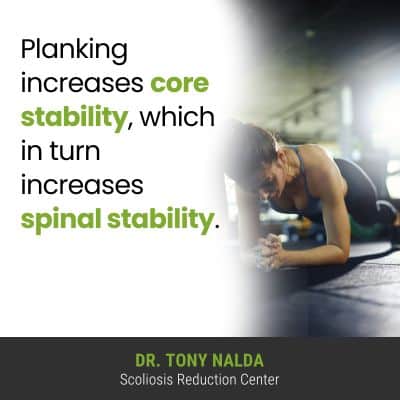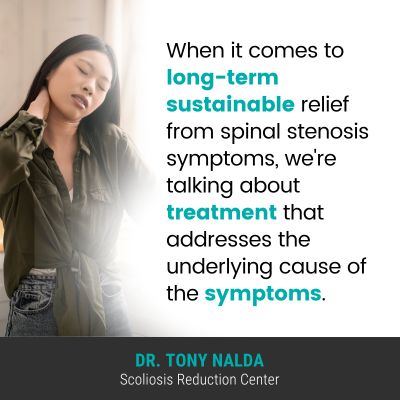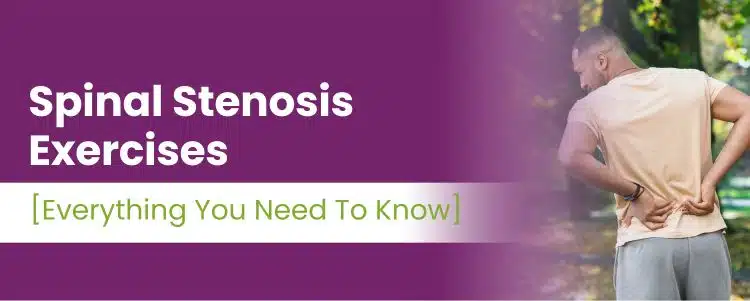When the spinal canal loses space, the nerves within can become compressed, pinched, and/or impinged, and this can cause a number of symptoms. When it comes to treating spinal stenosis for long-term results, the first step is determining its underlying cause.
Spinal stenosis occurs when the spinal canal, containing 31 pairs of spinal nerves, narrows; this can cause the nerves within to become compressed and disrupt their function. Spinal stenosis has various causes, and exercises for spinal stenosis can help relieve symptoms.
Let’s start our exploration of spinal stenosis exercises by first discussing some basic spinal anatomy.
Spinal Anatomy
The spine is a key structure of human anatomy; it helps us to stand upright, practice good posture, move flexibly, protects important organs, and works with the brain to form the central nervous system (CNS).
The central nervous system is a vast communication network that allows the brain to communicate with the rest of the body, so the spine is involved in the function of virtually every working part and system in the body, and this is why spinal conditions can cause such a wide range of symptoms.
The spine consists of vertebrae (bones of the spine) stacked on top of one another in a straight and neutral alignment, and adjacent vertebrae are separated by an intervertebral disc, and if the spine’s natural and healthy curves are in place, it’s aligned as it should be.
The spine has three main sections, and each has its own characteristic curvature type: the cervical spine (neck), the thoracic spine (middle/upper back), and the lumbar spine (lower back).
In a healthy spine that’s functioning optimally, its natural curves will be in place; the spine’s curves make it stronger, more flexible, and better able to absorb/distribute mechanical stress during movement.
The vertebrae have hollow openings, so a canal is formed through which the spinal nerves pass, and they exit the spine and branch off to different areas of the body.
In most spinal conditions, the area of the body located closest to the affected area of the spine is going to feel the majority of its direct effects, and this is often the case with spinal stenosis.
What is Spinal Stenosis?
Spinal stenosis occurs as the spinal canal is losing space, either directly in the middle or in and around the vertebral bodies, disrupting the ability of the nerves within to function optimally.
The loss of space within the spinal canal can involve a loss of space in the center of the spine, where nerves exit the spine, and/or in the spaces between the vertebrae.
Some people don’t experience symptoms of spinal stenosis, while others experience mild to moderate and severe effects.
Symptoms of Spinal Stenosis
Symptoms of spinal stenosis will vary from person to person based on cause and severity; most often, symptoms are felt in the neck and/or lower back because spinal stenosis most commonly affects the lumbar spine and the cervical spine.
Spinal stenosis symptoms can include:
- Numbness
- Tingling sensations
- Neck pain (common in cervical spinal stenosis)
- Back pain
- Sciatic nerve pain (common in lumbar spinal stenosis)
- Muscle weakness (arms and/or legs)
- Disruptions to balance and/or gait
- Bladder and/or bowel issues
- Sexual function issues
So what can exercises for spinal stenosis do?
Spinal Stenosis Exercises
Exercises for spinal stenosis are often recommended for reducing pressure and pain.
It’s important to understand, however, that no form of exercise can actually widen the spinal canal, but certain strengthening exercises can help minimize symptoms and improve spinal flexibility so a healthy activity level can be maintained.
It’s not just the spine that has to maintain its natural curves and alignment but also the spine’s surrounding muscles that provide it with crucial support and stabilization, and it’s thought that core strengthening exercises can help alleviate symptoms of spinal stenosis by increasing the spine’s support/stabilization.
The following exercises have been shown to positively impact spinal stenosis symptoms:
Planking
Planking has a number of benefits when it comes to increasing the back and abdominal muscles for better spinal support.
With spinal stenosis, there is uneven pressure on the nerves within the spinal canal, and in some cases, relieving that pressure through condition-specific exercise can help.
Planking, either a traditional or side plank, engages the core as it has to support the weight of the body and remain in the plank position, and the strengthening benefits planking provides can help alleviate pressure on the spine and its nerves and nerve roots within and where they exit the spine.
A traditional plank is performed by lying flat on the floor with elbows bent and the hands held in tight to the shoulders; lift the body while staying parallel to the floor and holding the position without letting the core sag.

A side plank is performed by lying on the left side with the knees bent and the elbow directly under the shoulder; while keeping the body straight, lift the hips while balancing on the elbow and knees and alternate sides.
Planking increases core stability, which in turn increases spinal stability.
Pelvic Tilts
With lumbar spinal stenosis, the narrowed spinal canal is in the lumbar spine, so the majority of its symptoms will be felt in the lower body.
The pelvic tilt can help increase abdominal strength and open up space within the pelvis and hips, and this can help relieve pressure on the lumbar spine, and keeping the pelvis loose and flexible means a healthier range of motion for the lower body, and it contributes to an economical gait, good posture, balance, and coordination.
Pelvic tilts are performed by lying on the back with the knees bent, feet flat on the floor, and with arms at the sides, slowly pushing the lower back into the floor while engaging the core.
Repeatedly naturally tilting the pelvis when the lower back comes into contact with the floor below helps to strengthen the lower back, maintain lumbar spine flexibility, and keep the pelvis strong and loose.
Knee to Chest Stretches
Knee to chest stretches are helpful for relieving sore lower back muscles and hips, along with improving hip, glute, and hamstring flexibility.
Lying on the back with both knees pulled into the chest while tightly grasping the knees and holding the position before lowering the legs helps stretch the lower back and pelvis. Alternate sides.
Now that we’ve addressed some exercises to help alleviate spinal stenosis symptoms, what are the most common causes of spinal stenosis?
Spinal Stenosis Causes
When it comes to long-term sustainable relief from spinal stenosis symptoms, we’re talking about treatment that addresses the underlying cause of the symptoms.
Treatment plans needs to be customized based on key patient/condition variables, one of which is causation, and while some people are born with smaller spinal canals, making them more susceptible to developing spinal stenosis, others are caused by osteoarthritis.
Arthritis of the Spine

Osteoarthritis is arthritis of the spine that involves tissue degeneration in the joints of the spine, but it also affects bone, cartilage, ligaments and fat: the entire joint.
Osteoarthritis is most common in the lumbar spine and can erode cartilage and change the very shape of bone, and when this occurs, it can cause inflammation and the thickening of ligaments and bone so there is less room within the spinal canal: compressing the nerves within or where they exit the spine.
Bone Spurs
Another common cause of spinal stenosis are bone spurs, which are bony overgrowths of bone that develop on the edges of bones, or where bones meet, in the joints; when there is a bony projection where there shouldn’t be, it’s projecting into space formerly used by its surroundings.
Spinal bone spurs can take space from the spine and its surrounding muscles and nerves.
Disc Degeneration
The spine’s intervertebral discs facilitate many aspects of spinal function: flexibility, shock absorption, cushioning to prevent friction, and structural support.
The discs are often the first spinal structures to feel the effects of degeneration, and degenerative disc disease is a contributing factor in the development of a number of spinal conditions/issues.
If a disc is degenerating in the lumbar or cervical spinal sections, it can change shape, and if a bulging disc becomes a herniated disc, the disc’s inner nucleus is spilling out through a tear in its outer annulus, encroaching on the space around the disc, and in cases of spinal stenosis, compressing a section of the spinal cord.
Disc degeneration is caused by a combination of natural age-related spinal degeneration and the cumulative effect of certain lifestyle factors.
Conclusion
Spinal stenosis exercises can help relieve symptoms of spinal stenosis, but for long-term sustainable pain relief, the underlying cause of the loss of space within the spine has to be determined and proactively addressed.
Some common symptoms of spinal stenosis include neck pain, back pain, tingling sensations, muscle weakness, changes to balance, gait, movement, digestive issues, bladder and/or bowel issues.
Once the underlying cause of the stenosis symptoms has been determined, a treatment plan can be customized based on key patient/condition variables, including causation, severity, and experienced symptoms.
Exercises can help relieve stenosis symptoms and minimize the condition’s effects by keeping the spine loose and strong, its surrounding muscles loose and strong so they can support and stabilize the spine, and taking pressure off its individual structures.
Exercises as part of treatment will need to be designed by a patient’s treatment provider, and here at the Scoliosis Reduction Center®, I’ve treated a number of spinal conditions, including stenosis; exercises like planking, pelvic tilts, and knee to chest stretches are stretching and strengthening exercises that can help relieve pressure from the spine, its nerves within, and the spine’s surroundings, and this can provide relief from a number of spinal stenosis symptoms.
When symptoms are addressed proactively through treatment that addresses their underlying cause, a healthy level of physical activity that benefits everyday life can be achieved.




